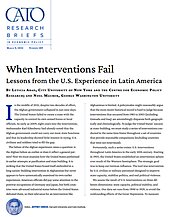The failure of the Afghan experiment raises a question: is the Afghan failure an outlier or does it reflect a general pattern? First we must examine how the United States performed in earlier attempts at pacification and state building. It is striking that the United States found itself embroiled in a long nation-building intervention in Afghanistan but never appears to have systematically examined its own earlier experiences. American officials did pay some attention to the postwar occupations of Germany and Japan, but both countries were advanced industrial states before the United States defeated them, so their relevance for an intervention like Afghanistan is limited. A policymaker might reasonably argue that the more recent historical record is hard to judge because interventions that occurred from 1983 to 2003 (including Grenada and Iraq) are astonishingly disparate both geographically and chronologically. To judge the United States’ success at state-building, we must study a series of interventions conducted in the same time frame throughout a set of countries that provide reasonable comparisons (including countries that were not intervened).
Fortunately, such a series exists: U.S. interventions throughout Latin America in the early 20th century. Starting in 1905, the United States established an intervention sphere over much of the Western hemisphere. The strategic goal was to keep out German influence. The tool was intervention by U.S. civilian or military personnel designed to improve state capacity, stabilize politics, and end political violence.
We assess the result of U.S. interventions on three different dimensions: state capacity, political stability, and violence. Our data set runs from 1900 to 1929, to avoid the confounding effects of the Great Depression. To measure state capacity, we collected customs revenue per capita, as trade taxes were the main source of public revenue for these countries. For political stability, we identified every unconstitutional or violent regime change or attempt at regime change. For violence, we included every conflict that surpassed 1,000 deaths in battle.
The results tell a sobering story about U.S. intervention. The United States failed at building state capacity: intervention was aimed at rooting out corruption in revenue collection, but revenue fell when the Americans took over. The first year of intervention saw a decline of real revenue per capita of around 17 percent. Continuing intervention only made matters worse.
Intervention appears to have worked better in terms of political stability. Intervention did correlate with a higher probability of a coup or coup attempt in the arriving year; the problem, of course, is that a higher probability of a coup or coup attempt at the beginning of an intervention is likely self-fulfilling, since the United States often intervened because instability had risen. Ongoing interventions, however, reduced the probability of a coup attempt by slightly more than 3 percentage points per year. These results hold when we exclude Cuba (1906–1909) and the Dominican Republic (1916–1922) from the data because in these two cases the United States assumed full sovereign control over the country, making coup attempts de jure impossible.
Intervention may have stabilized governments, but it failed when it came to keeping the peace. The probability of war increased with the arrival of the Americans—although, again, this is because violent outbreaks often prompted the Americans to intervene. The likelihood of war did not, however, decline during ongoing interventions. In other words, the onset of war tended to coincide with the arrival of American officials, but it did not then decrease the longer the Americans stayed. Put another way, the United States found it easy to get into wars but difficult to get out of them.
Overall, U.S. soldiers, marines, and civilian administrators were able to reduce violence (slightly, in some circumstances) and stabilize governments (more strongly). However, they were not capable of increasing the intervened states’ capacity to govern.
In this light, the American experience in Afghanistan seems less like an outlier and more like a continuation. The intervention brought stability in the sense that the U.S.- backed government did not face coup attempts or violent successions. The United States, however, was not able to end the conflict. And as in Latin America a century before, the United States failed to increase the ability of the Afghan state to carry out its most basic functions.
Broadly speaking, early-20th-century U.S. strategy in Latin America differed from early-21st-century U.S. strategy in Afghanistan in two respects. First, in Latin America the United States generally installed Americans inside the local government’s chain of command. In Afghanistan, conversely, the United States was careful to give the Afghans “ownership” of their government, out of fear that giving responsibility to Americans would remove accountability from Afghan officials and delegitimize the Afghan state. Second, with the significant exception of Nicaragua in 1912–1933, the United States did not directly subsidize the governments of intervened states in Latin America.
These differences do not appear to have mattered for the outcome in Afghanistan. Placing American officials directly inside the governmental chain of command in Latin America did little to reduce corruption. Doing the opposite in Afghanistan, however, failed to incentivize Afghan actors to perform better, as Ambassador Eikenberry noted as early as 2009. Similarly, subsidizing the operations of the ineffectual Afghan state in 2001–2021 proved no more successful than subsidizing the ineffectual Nicaraguan state had been in 1912–1933. What the United States has not been able to do, either in the 20th century or in this one, is build effective states or create enduring stability where it did not already exist.
Note
This research brief is based on Leticia Abad and Noel Maurer, “When Interventions Fail: Lessons from the U.S. Experience in Latin America,” Centre for Economic Policy Research Discussion Paper no. 16585, September 2021, https://cepr.org/active/publications/discussion_papers/dp.php?dpno=16585.

